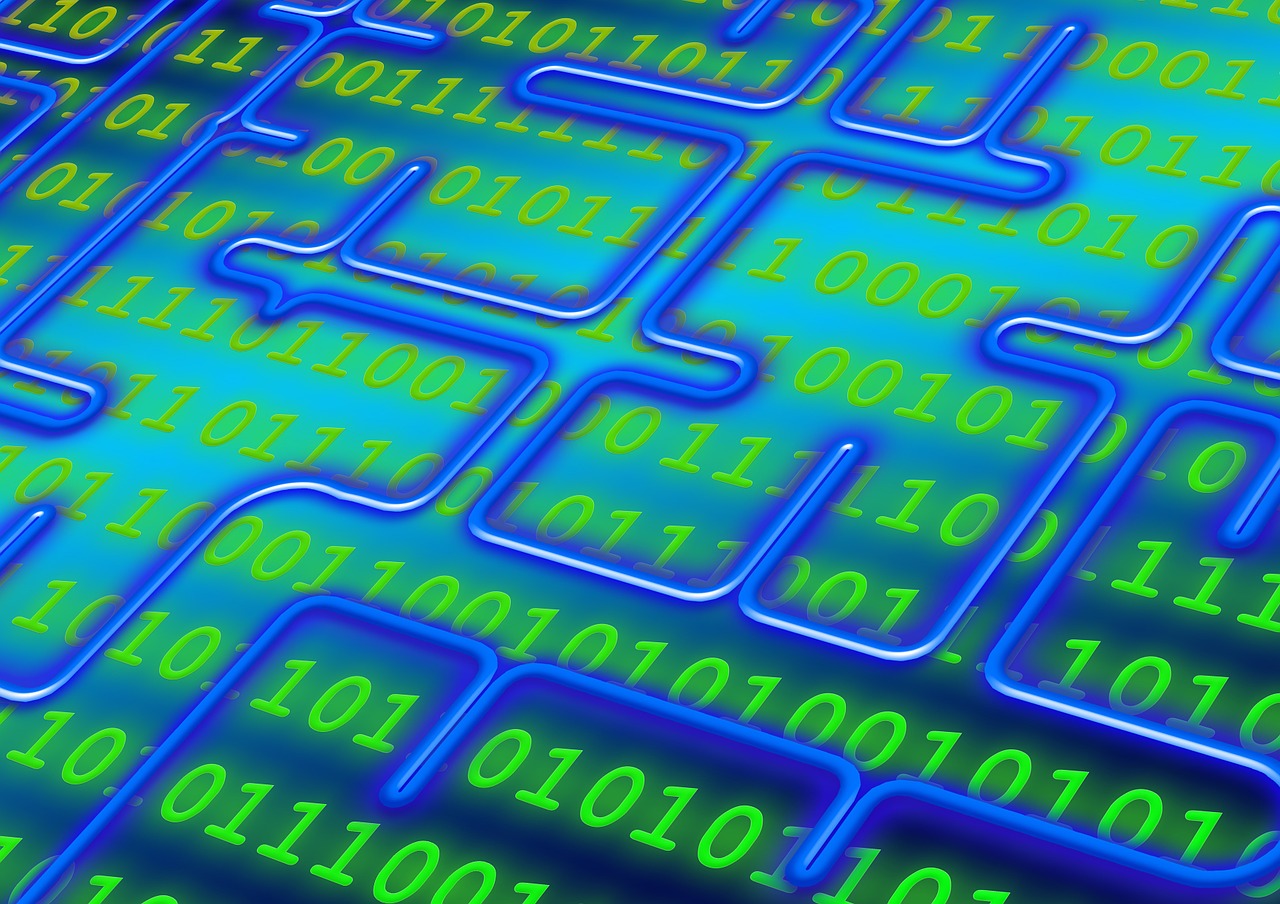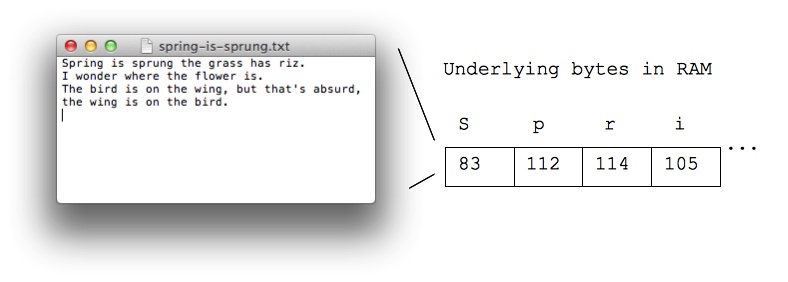
by Matt Druce | Jul 13, 2015 | Jargon
Bits and Bytes
At the smallest scale in the computer, information is stored as bits and bytes. In this section, we’ll look at how that works.
- Bit, like an atom, the smallest unit of storage
- A bit stores just a 0 or 1
- “In the computer it’s all 0’s and 1’s” … bits
- Anything with two separate states can store 1 bit
- -Nick’s tennis racket example
- Chip uses areas of electric charge as 0/1 states
- Hard drive uses spots North/South magnetism 0/1 states
- A bit is too small to be much use
- Group 8 bits into a byte
Everything in a computer is 0’s and 1’s … what does that mean? The bit stores just a 0 or 1 .. it’s the smallest building block of storage.
- One byte = grouping of 8 bits
- e.g. 0 1 0 1 1 0 1 0
- One byte can store one letter, e.g. ‘A’ or ‘x’
How much exactly can one byte hold?
How many distinct patterns can be made with 1, 2, or 3 bits?
| Number of bits |
Distinct Patterns |
| 1 |
0 1 |
| 2 |
00 01 10 11 |
| 3 |
000 001 010 011
100 101 110 111 |
- 3 bits vs. 2 bits
- Consider just the leftmost bit
- It can only be 0 or 1
- Lefmost bit is 0, then append 2-bit patterns
- Leftmost bit is 1, then append 2-bit patterns again
- Result … 3-bits has twice as many patterns as 2-bits
| Number of bits |
Distinct Patterns |
| 1 |
0 1 |
| 2 |
00 01 10 11 |
| 3 |
000 001 010 011
100 101 110 111 |
- In general: add 1 bit, double the number of patterns
- 1 bit – 2 patterns
- 2 bits – 4
- 3 bits – 8
- 4 bits – 16
- 5 bits – 32
- 6 bits – 64
- 7 bits – 128
- 8 bits – 256
- Mathematically: n bits yields 2n patterns (2 to the nth power)
One Byte – 256 Patterns
- Need to know:
- 1 byte is group of 8 bits
- 8 bits can make 256 different patterns
- How to use the 256 patterns?
- How to store a number in a byte?
- Start with 0, go up, one pattern per number, until run out of patterns
- 0, 1, 2, 3, 4, 5, … 254, 255
- One byte holds a number 0..255
- i.e. with 256 distinct patterns, we can store a number in the range 0..255
- Code: pixel.setRed(n) took a number 0..255. Why?
- The red/green/blue image numbers are each stored in one byte
Bytes
- “Byte” – unit of information storage
- A document, an image, a movie .. how many bytes?
- 1 byte is enough to hold 1 typed letter, e.g. ‘b’ or ‘X’
- Later we’ll look at storage in: RAM, hard drives, flash drives
- All measured in bytes, despite being very different hardware
- Kilobyte, KB, about 1 thousand bytes
- Megabyte, MB, about 1 million bytes
- Gigabyte, GB, about 1 billion bytes
- Terabyte, TB, about 1 trillion bytes (rare)
The space that data takes up in the computer is measured in by the “byte”. One byte is big enough to hold a single typed letter, like ‘a’. Here we’ll look at storing data in RAM memory and in persistent storage like a hard drive. All of that storage space will be measured in bytes. We’ll look at byte arithmetic in more detail later.
Bytes and Letters – ASCII Code
- ASCII is an encoding representing each typed letter by number
- Each number is stored in one byte of space in the computer (0..255)
- A is 65
- B is 66
- a is 96
- space is 32
- “Unicode” is an encoding for chinese, greek, arabic, etc. languages, typically 2-bytes per “letter”
32 space
33 !
34 "
35 #
36 $
37 %
38 &
39 '
40 (
41 )
42 *
43 +
44 ,
45 -
46 .
47 /
48 0
49 1
50 2
51 3
52 4
53 5
54 6
55 7
56 8
57 9
58 :
59 ;
60 <
61 =
62 >
63 ?
64 @
|
65 A
66 B
67 C
68 D
69 E
70 F
71 G
72 H
73 I
74 J
75 K
76 L
77 M
78 N
79 O
80 P
81 Q
82 R
83 S
84 T
85 U
86 V
87 W
88 X
89 Y
90 Z
91 [
92 \
93 ]
94 ^
95 _
96 `
|
97 a
98 b
99 c
100 d
101 e
102 f
103 g
104 h
105 i
106 j
107 k
108 l
109 m
110 n
111 o
112 p
113 q
114 r
115 s
116 t
117 u
118 v
119 w
120 x
121 y
122 z
123 {
124 |
125 }
126 ~
|
Typing, Bytes, and You
- An example of bytes in your daily life
- When you type letters on your phone or computer
- Each letter is stored as a number in a byte, as below
- When you send, say, a text message, the numbers are sent
- Text is quite compact, using few bytes, compared to images etc.

< CS101 (This Link directs to the pages source content https://web.stanford.edu/class/cs101/bits-bytes.html)
(This page is a replica of https://web.stanford.edu/class/cs101/bits-bytes.html. This page serves to uphold the integrity of another story on this website for the sole purpose of understanding and education. Full rights go to it’s owners at https://web.stanford.edu.)

